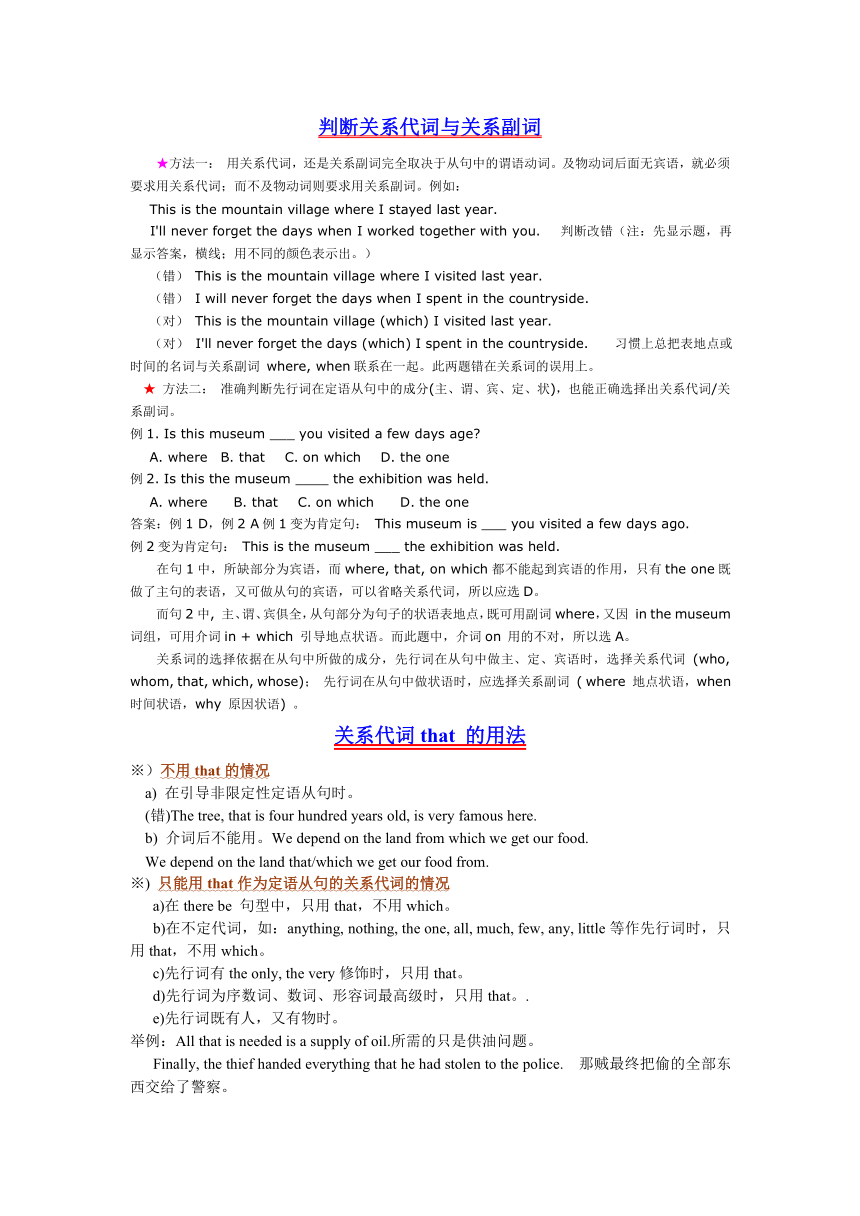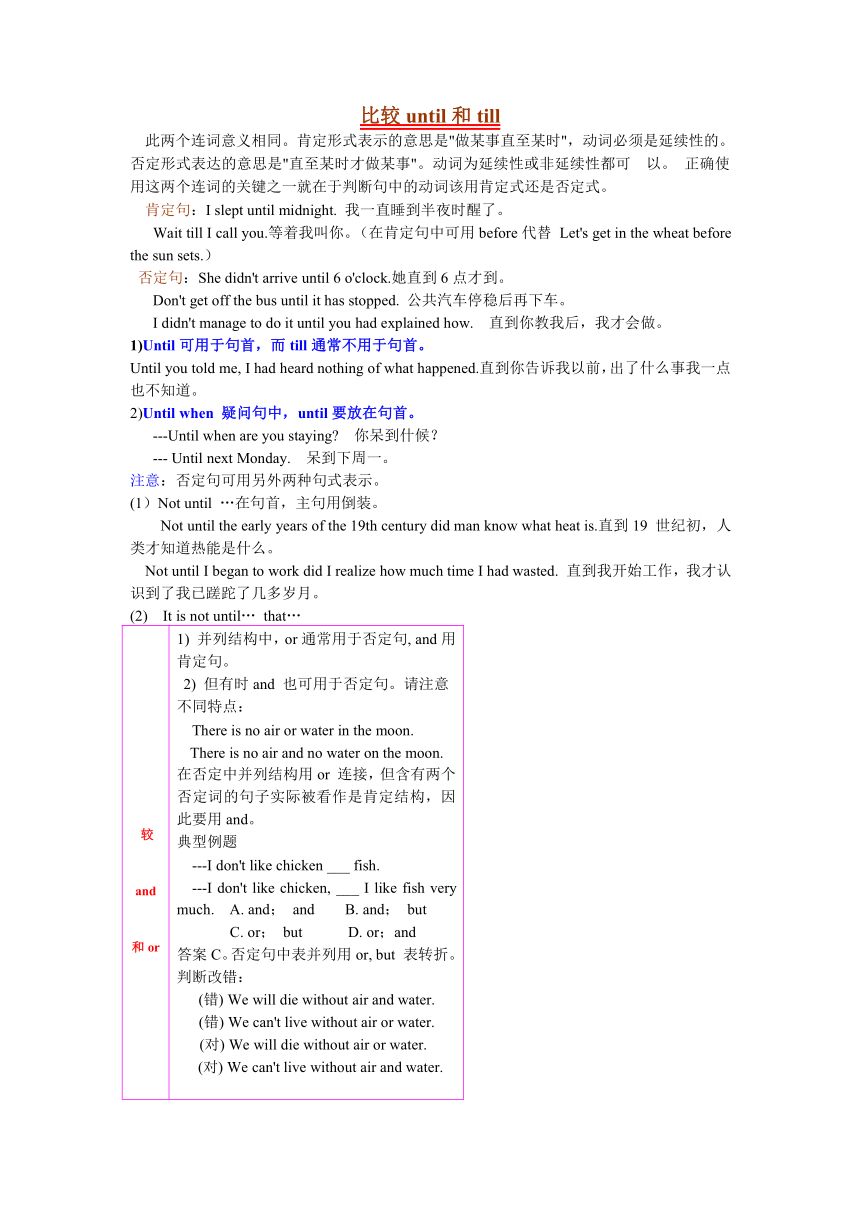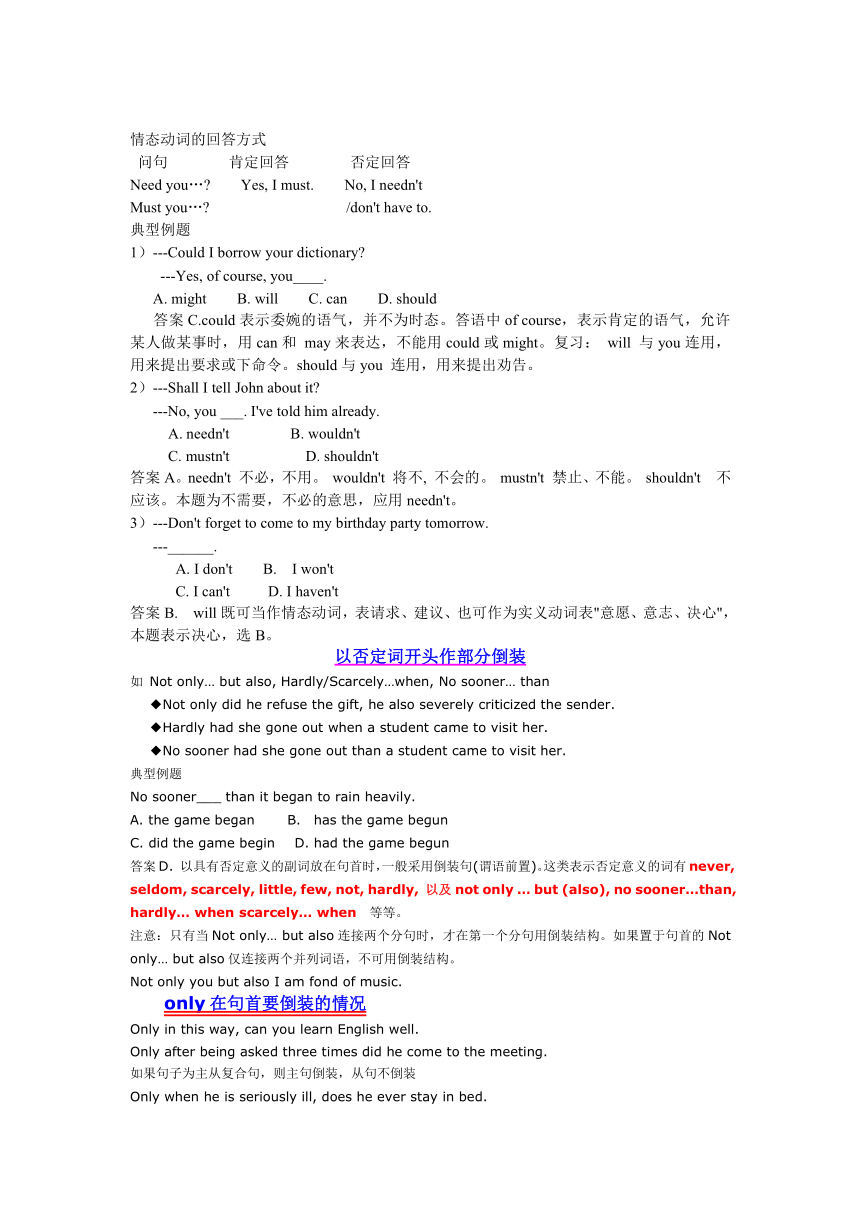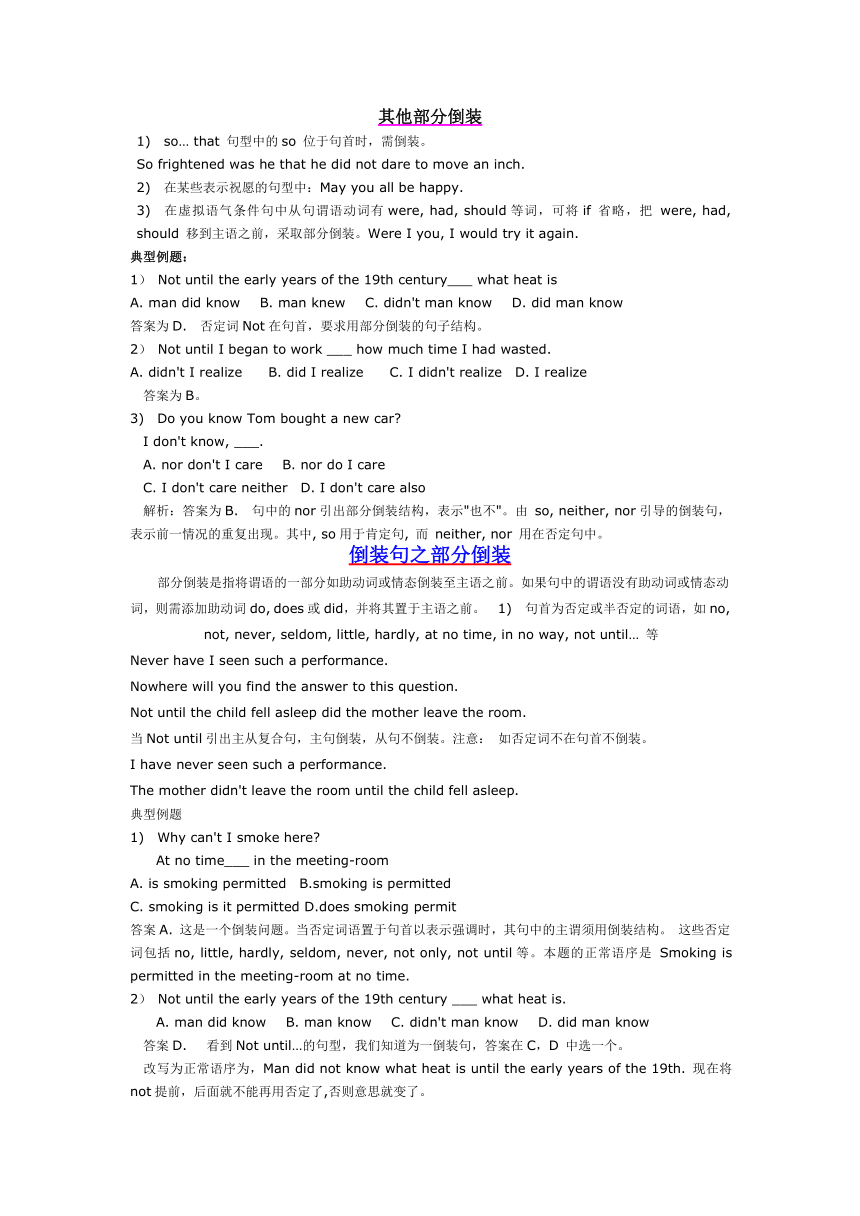判断关系代词与关系副词
图片预览




文档简介
判断关系代词与关系副词
★方法一: 用关系代词,还是关系副词完全取决于从句中的谓语动词。及物动词后面无宾语,就必须要求用关系代词;而不及物动词则要求用关系副词。例如:
This is the mountain village where I stayed last year.
I'll never forget the days when I worked together with you. 判断改错(注:先显示题,再显示答案,横线;用不同的颜色表示出。)
(错) This is the mountain village where I visited last year.
(错) I will never forget the days when I spent in the countryside.
(对) This is the mountain village (which) I visited last year.
(对) I'll never forget the days (which) I spent in the countryside. 习惯上总把表地点或时间的名词与关系副词 where, when联系在一起。此两题错在关系词的误用上。
★ 方法二: 准确判断先行词在定语从句中的成分(主、谓、宾、定、状),也能正确选择出关系代词/关系副词。
例1. Is this museum ___ you visited a few days age
A. where B. that C. on which D. the one
例2. Is this the museum ____ the exhibition was held.
A. where B. that C. on which D. the one
答案:例1 D,例2 A例1变为肯定句: This museum is ___ you visited a few days ago.
例2变为肯定句: This is the museum ___ the exhibition was held.
在句1中,所缺部分为宾语,而where, that, on which都不能起到宾语的作用,只有the one既做了主句的表语,又可做从句的宾语,可以省略关系代词,所以应选D。
而句2中, 主、谓、宾俱全,从句部分为句子的状语表地点,既可用副词where,又因 in the museum词组,可用介词in + which 引导地点状语。而此题中,介词on 用的不对,所以选A。
关系词的选择依据在从句中所做的成分,先行词在从句中做主、定、宾语时,选择关系代词 (who, whom, that, which, whose); 先行词在从句中做状语时,应选择关系副词 ( where 地点状语,when 时间状语,why 原因状语) 。
关系代词that 的用法
※)不用that的情况
a) 在引导非限定性定语从句时。
(错)The tree, that is four hundred years old, is very famous here.
b) 介词后不能用。We depend on the land from which we get our food.
We depend on the land that/which we get our food from.
※) 只能用that作为定语从句的关系代词的情况
a)在there be 句型中,只用that,不用which。
b)在不定代词,如:anything, nothing, the one, all, much, few, any, little等作先行词时,只用that,不用which。
c)先行词有the only, the very修饰时,只用that。
d)先行词为序数词、数词、形容词最高级时,只用that。.
e)先行词既有人,又有物时。
举例:All that is needed is a supply of oil.所需的只是供油问题。
Finally, the thief handed everything that he had stolen to the police. 那贼最终把偷的全部东西交给了警察。
比较until和till
此两个连词意义相同。肯定形式表示的意思是"做某事直至某时",动词必须是延续性的。否定形式表达的意思是"直至某时才做某事"。动词为延续性或非延续性都可 以。 正确使用这两个连词的关键之一就在于判断句中的动词该用肯定式还是否定式。
肯定句:I slept until midnight. 我一直睡到半夜时醒了。
Wait till I call you.等着我叫你。(在肯定句中可用before代替 Let's get in the wheat before the sun sets.)
否定句:She didn't arrive until 6 o'clock.她直到6点才到。
Don't get off the bus until it has stopped. 公共汽车停稳后再下车。
I didn't manage to do it until you had explained how. 直到你教我后,我才会做。
1)Until可用于句首,而till通常不用于句首。
Until you told me, I had heard nothing of what happened.直到你告诉我以前,出了什么事我一点也不知道。
2)Until when 疑问句中,until要放在句首。
---Until when are you staying 你呆到什候?
--- Until next Monday. 呆到下周一。
注意:否定句可用另外两种句式表示。
(1)Not until …在句首,主句用倒装。
Not until the early years of the 19th century did man know what heat is.直到19 世纪初,人类才知道热能是什么。
Not until I began to work did I realize how much time I had wasted. 直到我开始工作,我才认识到了我已蹉跎了几多岁月。
(2) It is not until… that…
比较and和or 1) 并列结构中,or通常用于否定句, and用肯定句。2) 但有时and 也可用于否定句。请注意不同特点:There is no air or water in the moon.There is no air and no water on the moon.在否定中并列结构用or 连接,但含有两个否定词的句子实际被看作是肯定结构,因此要用and。典型例题---I don't like chicken ___ fish.---I don't like chicken, ___ I like fish very much. A. and; and B. and; but C. or; but D. or;and答案C。否定句中表并列用or, but 表转折。判断改错:(错) We will die without air and water.(错) We can't live without air or water.(对) We will die without air or water. (对) We can't live without air and water.
情态动词的回答方式
问句 肯定回答 否定回答
Need you… Yes, I must. No, I needn't
Must you… /don't have to.
典型例题
1)---Could I borrow your dictionary
---Yes, of course, you____.
A. might B. will C. can D. should
答案C.could表示委婉的语气,并不为时态。答语中of course,表示肯定的语气,允许某人做某事时,用can和 may来表达,不能用could或might。复习: will 与you连用,用来提出要求或下命令。should与you 连用,用来提出劝告。
2)---Shall I tell John about it
---No, you ___. I've told him already.
A. needn't B. wouldn't
C. mustn't D. shouldn't
答案A。needn't 不必,不用。 wouldn't 将不, 不会的。 mustn't 禁止、不能。 shouldn't 不应该。本题为不需要,不必的意思,应用needn't。
3)---Don't forget to come to my birthday party tomorrow.
---______.
A. I don't B. I won't
C. I can't D. I haven't
答案B. will既可当作情态动词,表请求、建议、也可作为实义动词表"意愿、意志、决心",本题表示决心,选B。
以否定词开头作部分倒装
如 Not only… but also, Hardly/Scarcely…when, No sooner… than
◆Not only did he refuse the gift, he also severely criticized the sender.
◆Hardly had she gone out when a student came to visit her.
◆No sooner had she gone out than a student came to visit her.
典型例题
No sooner___ than it began to rain heavily.
A. the game began B. has the game begun
C. did the game begin D. had the game begun
答案D. 以具有否定意义的副词放在句首时,一般采用倒装句(谓语前置)。这类表示否定意义的词有never, seldom, scarcely, little, few, not, hardly, 以及not only … but (also), no sooner…than, hardly… when scarcely… when 等等。
注意:只有当Not only… but also连接两个分句时,才在第一个分句用倒装结构。如果置于句首的Not only… but also仅连接两个并列词语,不可用倒装结构。
Not only you but also I am fond of music.
only在句首要倒装的情况
Only in this way, can you learn English well.
Only after being asked three times did he come to the meeting.
如果句子为主从复合句,则主句倒装,从句不倒装
Only when he is seriously ill, does he ever stay in bed.
其他部分倒装
1) so… that 句型中的so 位于句首时,需倒装。
So frightened was he that he did not dare to move an inch.
2) 在某些表示祝愿的句型中:May you all be happy.
3) 在虚拟语气条件句中从句谓语动词有were, had, should等词,可将if 省略,把 were, had, should 移到主语之前,采取部分倒装。Were I you, I would try it again.
典型例题:
1) Not until the early years of the 19th century___ what heat is
A. man did know B. man knew C. didn't man know D. did man know
答案为D. 否定词Not在句首,要求用部分倒装的句子结构。
2) Not until I began to work ___ how much time I had wasted.
A. didn't I realize B. did I realize C. I didn't realize D. I realize
答案为B。
3) Do you know Tom bought a new car
I don't know, ___.
A. nor don't I care B. nor do I care
C. I don't care neither D. I don't care also
解析:答案为B. 句中的nor引出部分倒装结构,表示"也不"。由 so, neither, nor引导的倒装句,表示前一情况的重复出现。其中, so用于肯定句, 而 neither, nor 用在否定句中。
倒装句之部分倒装
部分倒装是指将谓语的一部分如助动词或情态倒装至主语之前。如果句中的谓语没有助动词或情态动词,则需添加助动词do, does或did,并将其置于主语之前。 1) 句首为否定或半否定的词语,如no, not, never, seldom, little, hardly, at no time, in no way, not until… 等
Never have I seen such a performance.
Nowhere will you find the answer to this question.
Not until the child fell asleep did the mother leave the room.
当Not until引出主从复合句,主句倒装,从句不倒装。注意: 如否定词不在句首不倒装。
I have never seen such a performance.
The mother didn't leave the room until the child fell asleep.
典型例题
1) Why can't I smoke here
At no time___ in the meeting-room
A. is smoking permitted B.smoking is permitted
C. smoking is it permitted D.does smoking permit
答案A. 这是一个倒装问题。当否定词语置于句首以表示强调时,其句中的主谓须用倒装结构。 这些否定词包括no, little, hardly, seldom, never, not only, not until等。本题的正常语序是 Smoking is permitted in the meeting-room at no time.
2) Not until the early years of the 19th century ___ what heat is.
A. man did know B. man know C. didn't man know D. did man know
答案D. 看到Not until…的句型,我们知道为一倒装句,答案在C,D 中选一个。
改写为正常语序为,Man did not know what heat is until the early years of the 19th. 现在将not提前,后面就不能再用否定了,否则意思就变了。
倒装句之全部倒装
全部倒装是只将句子中的谓语动词全部置于主语之前。此结构通常只用与一般现在时和 一般过去时。常见的结构有:
1) here, there, now, then, thus等副词置于句首, 谓语动词常用be, come, go, lie, run。
There goes the bell.
Then came the chairman.
Here is your letter. 2) 表示运动方向的副词或地点状语置于句首,谓语表示运动的动词。
Out rushed a missile from under the bomber.
Ahead sat an old woman.
注意:上述全部倒装的句型结构的主语必须是名词,如果主语是人称代词则不能完全倒装。
Here he comes. Away they went.
so, neither, nor作部分倒装
表示"也"、"也不" 的句子要部分倒装。
Tom can speak French. So can Jack.
If you won't go, neither will I.
典型例题
---Do you know Jim quarreled with his brother
---I don't know, _____.
A. nor don't I care B. nor do I care
C. I don't care neither D. I don't care also
答案:B. nor为增补意思"也不关心",因此句子应倒装。A错在用 don't 再次否定, C neither 用法不对且缺乏连词。 D缺乏连词。
注意: 当so引出的句子用以对上文内容加以证实或肯定时,不可用倒装结构。意为"的确如此"。
Tom asked me to go to play football and so I did. ---It's raining hard. ---So it is.
分词作定语
分词前置:We can see the rising sun. 我们可以看到东升的旭日。He is a retired worker. 他是位退休的工人
分词后置 (i.分词词组;ii. 个别分词如given, left; iii. 修饰不定代词 something等)
There was a girl sitting there. 有个女孩坐在那里
This is the question given. 这是所给的问题
There is nothing interesting.没有有趣的东西
过去分词作定语
与其修饰的词是被动关系,相当于一个被动语态的定语从句。
Most of the people invited to the party were famous scientists.
Most of the artists invited to the party were from South Africa.
典型例题
1) The first textbook ___ for teaching English as a foreign language came out in the 16th century.
A. have written B. to be written
C. being written D. written
答案D. 书与写作是被动关系,应用过去分词做定语表被 动,相当于定语从句 which is written
2)What's the language ____ in Germany
A. speaking B. spoken C. be spoken D. to speak
答案B. 主语language与谓语动词之间有被动的含义。
spoken是动词speak的过去分词形式,在句中作定语,修饰主语language, spoken 与 language有被动关系。该句可以理解为:
What's the language (which is) spoken in German
分词作状语
As I didn't receive any letter from him, I gave him a call.
-> Not receiving any letter from him, I gave him a call.由于没有收到他的信,我给他打了电话。
If more attention was given, the trees could have grown better.
-> Given more attention,the trees could have grown better. 假如多给些照顾,那些树会长得更好。
典型例题
1)_____ some officials, Napoleon inspected his army.
A. Followed B. Followed by
C. Being followed D. Having been followed
答案B. Napoleon 与follow 之间有被动的含义。being followed除表达被动之外,还有动作正在进行之意。 followed by(被…跟随)。本题可改为: With some officials following, Napoleon inspected his army.
2)There was a terrible noise ___ the sudden burst of light.
A. followed B. following
C. to be followed D. being followed
答案B. 由于声音在闪电后,因此为声跟随着光,声音为跟随的发出者,为主动。用现在分词。
3)_______, liquids can be changed into gases.
A. Heating B. To be heated
C. Heated D. Heat
答案C. 本题要选一分词作为状语。现在分词表主动,正在进行的;过去分词表被动的,已经完成的。对于液体来说是加热的受动者,是被动的,因而选C。它相当于一个状语从句 When it is heated,…
注意: 选择现在分词还是过去分词,关键看主句的主语。如分词的动作是主句的主语发出,分词就选用现在分词,反之就用过去分词。
(Being ) used for a long time, the book looks old.由于用了很长时间,这本书看上去很旧。
Using the book, I find it useful. 在使用的过程中, 我发现这本书很有用。
分词作补语
通常在感官动词和使役动词之后,如:I found my car missing. 我发现我的车不见了。
I'll have my watch repaired. 我想把我的手表修一下。
分词的时态
1)与主语动词同时,
Hearing the news, he jumped with joy. 听到这一消息,他高兴得手舞足蹈。
Arriving there, they found the boy dead. 刚一到那儿,他们就发现那男孩死了。
典型例题
The secretary worked late into the night, ___a long speech for the president.
A. to prepare B. preparing
C. prepared D. was preparing
答案B. 此处没有连词,不能选D,否则出现了两个谓语动词worked和was preparing。 只能在B,C中选一个。又因前后两个动作同时发生,且与主语为主动关系,应用现在分词。
2)先于主动词
While walking in the garden,he hurt his leg. 在花园里散步时他伤了腿。
分词作时间状语,如果先与主动词的动作,且强调先后, 要用having done。
Having finished his homework, he went out.
=As he had finished his homework, he went out.做完作业后,他出去了。
典型例题
___ a reply, he decided to write again.
A. Not receiving B. Receiving not
C. Not having received D. Having not received
答案C. 本题考查分词的时态与分词的否定式。根据题意判断,分词的动作(接信)发生在谓语动词的动作(决心再写信)之前,因此用分词的完成式。分词的否定式的构成为not +分词,故选C。该句可理解为:Because he had not received a reply, he decided to write again.
连词+分词(短语)
有时为使分词短语与主句关系更清楚,可在分词前加连词。 连词有: when,while,if though,after, before, as. 但分词的主语和主句的主语必须为同一个,如:While waiting there, he saw two pretty girls come out of the building.“waiting 和saw ”的主语相同。
With的复合结构作独立主格
表伴随时,既可用分词的独立结构,也可用with的复合结构。 with +名词(代词)+现在分词/过去分词/形容词/副词/不定式/介词短语
举例: He stood there, his hand raised.
= He stood there, with his hand raise.
典型例题
The murder was brought in, with his hands ___ behind his back。
A. being tied B. having tied
C. to be tied D. tied
答案D. with +名词(代词)+分词+介词短语结构。当分词表示伴随状况时,其主语常常用with来引导。由于本句中名词"手"与分词"绑"是被动关系,因此用过去分词,选D.
注意:
1) 独立主格结构使用介词的问题:
当介词是in时,其前后的两个名词均不加任何成分(如物主代词或冠词),也不用复数。但 with 的复合结构不受此限制
A robber burst into the room, knife in hand. ( hand前不能加his)。
2) 当表人体部位的词做逻辑主语时,及物动词用现在分 词,不及物动词用过去分词。
He lay there, his teeth set, his hand clenched, his eyes looking straight up.
典型例题:
Weather___, we'll go out for a walk.
A permitted B permitting
C permits D for permitting
答案B. 本题中没有连词,它不是复合句,也不是并列句。 句中使用了逗号,且we 小写,可知其不是两个简单句。能够这样使用的只有独立主格或with的复合结构。据此判断,本句中使用的是独立结构, 其结构为:名词+分词。 由于permit在这里翻译为'天气允许',表主动,应用现在分词,故选B。
如果不会判断独立结构作状语的形式,不妨将句子改为条件句,例如本句改为If weather permits, we'll go out for a walk. 然后将if 去掉,再将谓语动词改为非谓语动词即可。
★方法一: 用关系代词,还是关系副词完全取决于从句中的谓语动词。及物动词后面无宾语,就必须要求用关系代词;而不及物动词则要求用关系副词。例如:
This is the mountain village where I stayed last year.
I'll never forget the days when I worked together with you. 判断改错(注:先显示题,再显示答案,横线;用不同的颜色表示出。)
(错) This is the mountain village where I visited last year.
(错) I will never forget the days when I spent in the countryside.
(对) This is the mountain village (which) I visited last year.
(对) I'll never forget the days (which) I spent in the countryside. 习惯上总把表地点或时间的名词与关系副词 where, when联系在一起。此两题错在关系词的误用上。
★ 方法二: 准确判断先行词在定语从句中的成分(主、谓、宾、定、状),也能正确选择出关系代词/关系副词。
例1. Is this museum ___ you visited a few days age
A. where B. that C. on which D. the one
例2. Is this the museum ____ the exhibition was held.
A. where B. that C. on which D. the one
答案:例1 D,例2 A例1变为肯定句: This museum is ___ you visited a few days ago.
例2变为肯定句: This is the museum ___ the exhibition was held.
在句1中,所缺部分为宾语,而where, that, on which都不能起到宾语的作用,只有the one既做了主句的表语,又可做从句的宾语,可以省略关系代词,所以应选D。
而句2中, 主、谓、宾俱全,从句部分为句子的状语表地点,既可用副词where,又因 in the museum词组,可用介词in + which 引导地点状语。而此题中,介词on 用的不对,所以选A。
关系词的选择依据在从句中所做的成分,先行词在从句中做主、定、宾语时,选择关系代词 (who, whom, that, which, whose); 先行词在从句中做状语时,应选择关系副词 ( where 地点状语,when 时间状语,why 原因状语) 。
关系代词that 的用法
※)不用that的情况
a) 在引导非限定性定语从句时。
(错)The tree, that is four hundred years old, is very famous here.
b) 介词后不能用。We depend on the land from which we get our food.
We depend on the land that/which we get our food from.
※) 只能用that作为定语从句的关系代词的情况
a)在there be 句型中,只用that,不用which。
b)在不定代词,如:anything, nothing, the one, all, much, few, any, little等作先行词时,只用that,不用which。
c)先行词有the only, the very修饰时,只用that。
d)先行词为序数词、数词、形容词最高级时,只用that。.
e)先行词既有人,又有物时。
举例:All that is needed is a supply of oil.所需的只是供油问题。
Finally, the thief handed everything that he had stolen to the police. 那贼最终把偷的全部东西交给了警察。
比较until和till
此两个连词意义相同。肯定形式表示的意思是"做某事直至某时",动词必须是延续性的。否定形式表达的意思是"直至某时才做某事"。动词为延续性或非延续性都可 以。 正确使用这两个连词的关键之一就在于判断句中的动词该用肯定式还是否定式。
肯定句:I slept until midnight. 我一直睡到半夜时醒了。
Wait till I call you.等着我叫你。(在肯定句中可用before代替 Let's get in the wheat before the sun sets.)
否定句:She didn't arrive until 6 o'clock.她直到6点才到。
Don't get off the bus until it has stopped. 公共汽车停稳后再下车。
I didn't manage to do it until you had explained how. 直到你教我后,我才会做。
1)Until可用于句首,而till通常不用于句首。
Until you told me, I had heard nothing of what happened.直到你告诉我以前,出了什么事我一点也不知道。
2)Until when 疑问句中,until要放在句首。
---Until when are you staying 你呆到什候?
--- Until next Monday. 呆到下周一。
注意:否定句可用另外两种句式表示。
(1)Not until …在句首,主句用倒装。
Not until the early years of the 19th century did man know what heat is.直到19 世纪初,人类才知道热能是什么。
Not until I began to work did I realize how much time I had wasted. 直到我开始工作,我才认识到了我已蹉跎了几多岁月。
(2) It is not until… that…
比较and和or 1) 并列结构中,or通常用于否定句, and用肯定句。2) 但有时and 也可用于否定句。请注意不同特点:There is no air or water in the moon.There is no air and no water on the moon.在否定中并列结构用or 连接,但含有两个否定词的句子实际被看作是肯定结构,因此要用and。典型例题---I don't like chicken ___ fish.---I don't like chicken, ___ I like fish very much. A. and; and B. and; but C. or; but D. or;and答案C。否定句中表并列用or, but 表转折。判断改错:(错) We will die without air and water.(错) We can't live without air or water.(对) We will die without air or water. (对) We can't live without air and water.
情态动词的回答方式
问句 肯定回答 否定回答
Need you… Yes, I must. No, I needn't
Must you… /don't have to.
典型例题
1)---Could I borrow your dictionary
---Yes, of course, you____.
A. might B. will C. can D. should
答案C.could表示委婉的语气,并不为时态。答语中of course,表示肯定的语气,允许某人做某事时,用can和 may来表达,不能用could或might。复习: will 与you连用,用来提出要求或下命令。should与you 连用,用来提出劝告。
2)---Shall I tell John about it
---No, you ___. I've told him already.
A. needn't B. wouldn't
C. mustn't D. shouldn't
答案A。needn't 不必,不用。 wouldn't 将不, 不会的。 mustn't 禁止、不能。 shouldn't 不应该。本题为不需要,不必的意思,应用needn't。
3)---Don't forget to come to my birthday party tomorrow.
---______.
A. I don't B. I won't
C. I can't D. I haven't
答案B. will既可当作情态动词,表请求、建议、也可作为实义动词表"意愿、意志、决心",本题表示决心,选B。
以否定词开头作部分倒装
如 Not only… but also, Hardly/Scarcely…when, No sooner… than
◆Not only did he refuse the gift, he also severely criticized the sender.
◆Hardly had she gone out when a student came to visit her.
◆No sooner had she gone out than a student came to visit her.
典型例题
No sooner___ than it began to rain heavily.
A. the game began B. has the game begun
C. did the game begin D. had the game begun
答案D. 以具有否定意义的副词放在句首时,一般采用倒装句(谓语前置)。这类表示否定意义的词有never, seldom, scarcely, little, few, not, hardly, 以及not only … but (also), no sooner…than, hardly… when scarcely… when 等等。
注意:只有当Not only… but also连接两个分句时,才在第一个分句用倒装结构。如果置于句首的Not only… but also仅连接两个并列词语,不可用倒装结构。
Not only you but also I am fond of music.
only在句首要倒装的情况
Only in this way, can you learn English well.
Only after being asked three times did he come to the meeting.
如果句子为主从复合句,则主句倒装,从句不倒装
Only when he is seriously ill, does he ever stay in bed.
其他部分倒装
1) so… that 句型中的so 位于句首时,需倒装。
So frightened was he that he did not dare to move an inch.
2) 在某些表示祝愿的句型中:May you all be happy.
3) 在虚拟语气条件句中从句谓语动词有were, had, should等词,可将if 省略,把 were, had, should 移到主语之前,采取部分倒装。Were I you, I would try it again.
典型例题:
1) Not until the early years of the 19th century___ what heat is
A. man did know B. man knew C. didn't man know D. did man know
答案为D. 否定词Not在句首,要求用部分倒装的句子结构。
2) Not until I began to work ___ how much time I had wasted.
A. didn't I realize B. did I realize C. I didn't realize D. I realize
答案为B。
3) Do you know Tom bought a new car
I don't know, ___.
A. nor don't I care B. nor do I care
C. I don't care neither D. I don't care also
解析:答案为B. 句中的nor引出部分倒装结构,表示"也不"。由 so, neither, nor引导的倒装句,表示前一情况的重复出现。其中, so用于肯定句, 而 neither, nor 用在否定句中。
倒装句之部分倒装
部分倒装是指将谓语的一部分如助动词或情态倒装至主语之前。如果句中的谓语没有助动词或情态动词,则需添加助动词do, does或did,并将其置于主语之前。 1) 句首为否定或半否定的词语,如no, not, never, seldom, little, hardly, at no time, in no way, not until… 等
Never have I seen such a performance.
Nowhere will you find the answer to this question.
Not until the child fell asleep did the mother leave the room.
当Not until引出主从复合句,主句倒装,从句不倒装。注意: 如否定词不在句首不倒装。
I have never seen such a performance.
The mother didn't leave the room until the child fell asleep.
典型例题
1) Why can't I smoke here
At no time___ in the meeting-room
A. is smoking permitted B.smoking is permitted
C. smoking is it permitted D.does smoking permit
答案A. 这是一个倒装问题。当否定词语置于句首以表示强调时,其句中的主谓须用倒装结构。 这些否定词包括no, little, hardly, seldom, never, not only, not until等。本题的正常语序是 Smoking is permitted in the meeting-room at no time.
2) Not until the early years of the 19th century ___ what heat is.
A. man did know B. man know C. didn't man know D. did man know
答案D. 看到Not until…的句型,我们知道为一倒装句,答案在C,D 中选一个。
改写为正常语序为,Man did not know what heat is until the early years of the 19th. 现在将not提前,后面就不能再用否定了,否则意思就变了。
倒装句之全部倒装
全部倒装是只将句子中的谓语动词全部置于主语之前。此结构通常只用与一般现在时和 一般过去时。常见的结构有:
1) here, there, now, then, thus等副词置于句首, 谓语动词常用be, come, go, lie, run。
There goes the bell.
Then came the chairman.
Here is your letter. 2) 表示运动方向的副词或地点状语置于句首,谓语表示运动的动词。
Out rushed a missile from under the bomber.
Ahead sat an old woman.
注意:上述全部倒装的句型结构的主语必须是名词,如果主语是人称代词则不能完全倒装。
Here he comes. Away they went.
so, neither, nor作部分倒装
表示"也"、"也不" 的句子要部分倒装。
Tom can speak French. So can Jack.
If you won't go, neither will I.
典型例题
---Do you know Jim quarreled with his brother
---I don't know, _____.
A. nor don't I care B. nor do I care
C. I don't care neither D. I don't care also
答案:B. nor为增补意思"也不关心",因此句子应倒装。A错在用 don't 再次否定, C neither 用法不对且缺乏连词。 D缺乏连词。
注意: 当so引出的句子用以对上文内容加以证实或肯定时,不可用倒装结构。意为"的确如此"。
Tom asked me to go to play football and so I did. ---It's raining hard. ---So it is.
分词作定语
分词前置:We can see the rising sun. 我们可以看到东升的旭日。He is a retired worker. 他是位退休的工人
分词后置 (i.分词词组;ii. 个别分词如given, left; iii. 修饰不定代词 something等)
There was a girl sitting there. 有个女孩坐在那里
This is the question given. 这是所给的问题
There is nothing interesting.没有有趣的东西
过去分词作定语
与其修饰的词是被动关系,相当于一个被动语态的定语从句。
Most of the people invited to the party were famous scientists.
Most of the artists invited to the party were from South Africa.
典型例题
1) The first textbook ___ for teaching English as a foreign language came out in the 16th century.
A. have written B. to be written
C. being written D. written
答案D. 书与写作是被动关系,应用过去分词做定语表被 动,相当于定语从句 which is written
2)What's the language ____ in Germany
A. speaking B. spoken C. be spoken D. to speak
答案B. 主语language与谓语动词之间有被动的含义。
spoken是动词speak的过去分词形式,在句中作定语,修饰主语language, spoken 与 language有被动关系。该句可以理解为:
What's the language (which is) spoken in German
分词作状语
As I didn't receive any letter from him, I gave him a call.
-> Not receiving any letter from him, I gave him a call.由于没有收到他的信,我给他打了电话。
If more attention was given, the trees could have grown better.
-> Given more attention,the trees could have grown better. 假如多给些照顾,那些树会长得更好。
典型例题
1)_____ some officials, Napoleon inspected his army.
A. Followed B. Followed by
C. Being followed D. Having been followed
答案B. Napoleon 与follow 之间有被动的含义。being followed除表达被动之外,还有动作正在进行之意。 followed by(被…跟随)。本题可改为: With some officials following, Napoleon inspected his army.
2)There was a terrible noise ___ the sudden burst of light.
A. followed B. following
C. to be followed D. being followed
答案B. 由于声音在闪电后,因此为声跟随着光,声音为跟随的发出者,为主动。用现在分词。
3)_______, liquids can be changed into gases.
A. Heating B. To be heated
C. Heated D. Heat
答案C. 本题要选一分词作为状语。现在分词表主动,正在进行的;过去分词表被动的,已经完成的。对于液体来说是加热的受动者,是被动的,因而选C。它相当于一个状语从句 When it is heated,…
注意: 选择现在分词还是过去分词,关键看主句的主语。如分词的动作是主句的主语发出,分词就选用现在分词,反之就用过去分词。
(Being ) used for a long time, the book looks old.由于用了很长时间,这本书看上去很旧。
Using the book, I find it useful. 在使用的过程中, 我发现这本书很有用。
分词作补语
通常在感官动词和使役动词之后,如:I found my car missing. 我发现我的车不见了。
I'll have my watch repaired. 我想把我的手表修一下。
分词的时态
1)与主语动词同时,
Hearing the news, he jumped with joy. 听到这一消息,他高兴得手舞足蹈。
Arriving there, they found the boy dead. 刚一到那儿,他们就发现那男孩死了。
典型例题
The secretary worked late into the night, ___a long speech for the president.
A. to prepare B. preparing
C. prepared D. was preparing
答案B. 此处没有连词,不能选D,否则出现了两个谓语动词worked和was preparing。 只能在B,C中选一个。又因前后两个动作同时发生,且与主语为主动关系,应用现在分词。
2)先于主动词
While walking in the garden,he hurt his leg. 在花园里散步时他伤了腿。
分词作时间状语,如果先与主动词的动作,且强调先后, 要用having done。
Having finished his homework, he went out.
=As he had finished his homework, he went out.做完作业后,他出去了。
典型例题
___ a reply, he decided to write again.
A. Not receiving B. Receiving not
C. Not having received D. Having not received
答案C. 本题考查分词的时态与分词的否定式。根据题意判断,分词的动作(接信)发生在谓语动词的动作(决心再写信)之前,因此用分词的完成式。分词的否定式的构成为not +分词,故选C。该句可理解为:Because he had not received a reply, he decided to write again.
连词+分词(短语)
有时为使分词短语与主句关系更清楚,可在分词前加连词。 连词有: when,while,if though,after, before, as. 但分词的主语和主句的主语必须为同一个,如:While waiting there, he saw two pretty girls come out of the building.“waiting 和saw ”的主语相同。
With的复合结构作独立主格
表伴随时,既可用分词的独立结构,也可用with的复合结构。 with +名词(代词)+现在分词/过去分词/形容词/副词/不定式/介词短语
举例: He stood there, his hand raised.
= He stood there, with his hand raise.
典型例题
The murder was brought in, with his hands ___ behind his back。
A. being tied B. having tied
C. to be tied D. tied
答案D. with +名词(代词)+分词+介词短语结构。当分词表示伴随状况时,其主语常常用with来引导。由于本句中名词"手"与分词"绑"是被动关系,因此用过去分词,选D.
注意:
1) 独立主格结构使用介词的问题:
当介词是in时,其前后的两个名词均不加任何成分(如物主代词或冠词),也不用复数。但 with 的复合结构不受此限制
A robber burst into the room, knife in hand. ( hand前不能加his)。
2) 当表人体部位的词做逻辑主语时,及物动词用现在分 词,不及物动词用过去分词。
He lay there, his teeth set, his hand clenched, his eyes looking straight up.
典型例题:
Weather___, we'll go out for a walk.
A permitted B permitting
C permits D for permitting
答案B. 本题中没有连词,它不是复合句,也不是并列句。 句中使用了逗号,且we 小写,可知其不是两个简单句。能够这样使用的只有独立主格或with的复合结构。据此判断,本句中使用的是独立结构, 其结构为:名词+分词。 由于permit在这里翻译为'天气允许',表主动,应用现在分词,故选B。
如果不会判断独立结构作状语的形式,不妨将句子改为条件句,例如本句改为If weather permits, we'll go out for a walk. 然后将if 去掉,再将谓语动词改为非谓语动词即可。
同课章节目录
- 词法
- 名词
- 动词和动词短语
- 动词语态
- 动词时态
- 助动词和情态动词
- 非谓语动词
- 冠词
- 代词
- 数词和量词
- 形容词副词及其比较等级
- 介词和介词短语
- 连词和感叹词
- 构词法
- 相似、相近词比较
- 句法
- 陈述句
- 一般疑问句和否定疑问句
- 特殊疑问句及选择疑问句
- 反意疑问句
- 存在句(There be句型)
- 宾语从句
- 定语从句
- 状语从句
- 主谓一致问题
- 简单句
- 并列句
- 复合句
- 主谓一致
- 主、表语从句
- 名词性从句
- 直接引语和间接引语
- 虚拟语气
- 感叹句
- 强调句
- 倒装句
- 祈使句
- 句子的成分
- 句子的分类
- 题型专区
- 单项选择部分
- 易错题
- 完形填空
- 阅读理解
- 词汇练习
- 听说训练
- 句型转换
- 补全对话
- 短文改错
- 翻译
- 书面表达
- 任务型阅读
- 语法填空
- 其他资料
